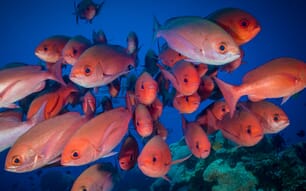The University of Victoria biologist is co-leader of a study that is uncovering the genetic secrets of that tiny nemesis of BCs wild and farmed salmonthe Pacific sea louse.
The marine parasiteseach a mere 2 cm long when fully grownfeed on the skin, mucous and flesh of host fish, weakening and, in some cases, killing them. Each year, sea lice cost the Canadian aquaculture industry millions of dollars in economic losses.
Perhaps most notoriously, sea lice are at the centre of an ongoing debate in BC over the risks posed to wild salmon by open net salmon farms.
Because the salmon-louse issue is so relevant to BC we were asked to look at it from a genetics perspective, says Koop. Policy decisions will be made by others, but first we need to do the science. The fact that we have so many basic questions tells us how little we know.
The three-year Genomics in Lice and Salmon (GiLS) project is using advanced genomics tools to understand how Pacific sea lice interact with their salmonid hosts.
Half of the study is looking at the effect of the lice on fish, says Koop. Which species of salmon are more susceptible to lice? How significant is fish size? What systems are affected in the fish? And how do temperature and salinity influence infection?
Koop and his colleagues are ideally suited to answer these questions because theyre world leaders in salmonid genomics. Over the last five years, theyve mapped about 90 per cent of the salmonid genome.
Weve identified about 35,000 genes, says Koop, who notes that all salmonidswhich include salmon, trout and charare closely related.
The team has also developed the worlds largest microarray chip for salmonidsan extraordinary tool for studying what each gene does. It allows us to assess how each of those genes responds to different environmental conditions or pathogens, says Koop. Its now in wide use around the world.
Because these chips can be used to study the responses of body systemssuch as reproductive, nervous, metabolicto varying conditions, they will be essential tools in the quest to understand what Koop describes as chemical warfare between salmon and louse.
This warfare begins as soon as a louse latches on to a salmon. Each organism mounts attack and defence responses against the other. Understanding these responses and the factors that influence them allows us to look at ways of controlling them.
But first, we need to know basic things about sea lice, which is the other half of the GiLS study. Were starting from scratch, building gene lists and tools, says Koop. Already, the team has identified 10,000 genes.
That led to their first big revelationthat the Pacific salmon louse is very different genetically from its Atlantic cousin. The margin is about 10 per centcomparable to a human and a chimpanzee, says Koop.
This may have significant management implications, since it had previously been assumed that research done in Norway and Scotland directly applied to sea lice everywhere.
Now we know that may not be so, says Koop. We can still learn from one another, but its likely that a made-in-BC solution is required here.
The major funder of the GiLS project is Genome BC. The project involves researchers at UVic, the Department of Fisheries and Oceans, Simon Fraser University and Vancouver Island University.
Genetics Tell the Secrets of Salmon Nemesis
BRITISH COLUMBIA, CANADA - New research is uncovering the genetic secrets of BCs most notorious marine parasite.




